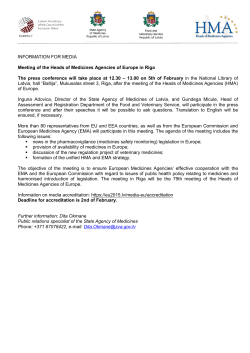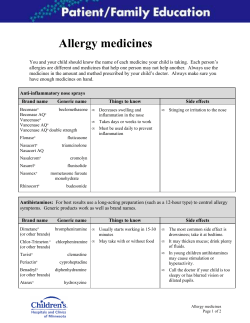
75 6. Closing remarks When the Task Force examines
6. Closing remarks When the Task Force examines the massive literature which has grown up over the last thirty years on the problems of access to medicines it is struck by the fact that almost every conceivable barrier to access has over the years been experienced, but also examined and tackled; very commonly realistic solutions have been devised. Sometimes those solutions have been successfully applied, especially where the approach has been a broad one. Ideally the Task Force would have wished to propose a relatively simple approach to the challenge of improving access to medicines. Because however the obstacles to access are many and diverse, and because they differ in nature and degree from one country to another this is not possible. One is obliged to point to an entire armoury of solutions, some of which need to be applied at the global level, while others need to be selectively employed in particular countries or regions depending on the situation which exists. At the risk of overshadowing the other vital issues presented in this report, , the Task Force would however point to four general matters which merit special attention and action at this time: • • • • the first of these is the complex and confusing structure of international aid in this field; it is not unlikely that more could be achieved, and the situation better assessed, if it were simplified by a merger of effort the second is the fact that the international community has to date produced more in the way of words than of deeds and dollars the third problem is that the existing flow of money in and around the pharmaceuticals field is poorly and unjustly apportioned; undue enrichment on a massive scale is to be seen alongside deprivation and neglect; scientific resources are primarily directed to detecting new medicinal benefits for the privileged few; the funds devoted worldwide to administration and promotion massively exceed those which could be used to right wrongs the fourth issue is that of human resources. Whether one is dealing with procurement, prescribing or patient behaviour one repeatedly finds that the resources available for medicinal care are too limited and that even those which exist are not being used to the best advantage. Education, information and follow-up training remain potent tools to change that situation. While the scene regarding access to medicines is complex it is in essence well understood. It is also increasingly evident that ensuring access to medicines brings both social and economic rewards which at the very least provide a full return on the investment necessary to attain that ideal. There is no real doubt that, despite the extensive poverty in the world, the world community as a whole is economically well able to provide all its citizens with at least a basic range of the essential medicines. What is essentially needed to turn that ideal into reality is political and social will, wide community support, the readiness on the part of many parties in society to abandon entrenched attitudes which have had their day, and a determination to reset global and national priorities in order to serve the greater good. 75 TABLE 4 SUMMARY OF PRINCIPAL RECOMMENDATIONS Numbers cross-refer to the full text of the recommendations FIELD 5.2. GENERAL PRINCIPLES National Recommendations International Recommendations Translate principles of human rights relating International organizations need to acknowledge to drug access into enforceable rights for the access to medicines as a human right individual 5.3. BARRIERS TO AVAILABILITY 5.3.1. Inadequate innovation • • • 5.3.2. Unreliable supply systems • • • Encourage advocacy for appropriate innovation and priority setting Provide policy, funding and infrastructure for research for national priority health needs Promote R and/or D for indigenous medicines • Promote all effective supply channels (public, private, NGO) giving priority to sustainable, reliable supply systems Provide clear regulations for supply systems Ensure judicial system enforces regulations • • • • • • Promote public investment in research for priority health needs of developing countries Create environment that mandates private sector to contribute to innovation in public health. Ensure international standards for ethical research are applied in all countries Promote information sharing on successful national and pooled supply strategies to enable innovation Provide producers with reliable forecasts of priority product requirements Promote international standards for procurement agencies Prequalify procurement agents 5.3.3. Unsafe medicines • • Strengthen drug regulatory authority with political support, financing, and staff Institute system for monitoring and redressing drug injury • • • • Enforce compliance with international GMP Share information about poor quality products and producers Set up system for sharing information on benefit-risk assessment and regulatory decisions (e.g., withdrawals) Prequalify and monitor priority products and suppliers and share this information (e.g., white list) 5.4. BARRIERS TO AFFORDABILITY 5.4.1. Unfair financing • • • • • Increase public sector budget for essential medicines and ensure equity of access Promote prepayment and insurance schemes including employer schemes Phase out user fees for essential medicines in favour of more equitable drug financing Institute performance based payment for providers Promote good donation practices as per international guidelines • • • • Increase total international financing for essential medicines targeting the poor Loans should not fund recurrent drug expenditures Provide comparative health and other sectoral accounts and pharmaceutical expenditure to encourage fair financing International financial assistance should support national health policies and systems 5.4.2. High prices • • • • Promote generic and therapeutic competition Monitor and regulate the prices of essential medicines Remove inappropriate tariffs and taxes and reduce inappropriate distribution and dispensing margins and informal payments Adapt and use national legislation to take advantage of TRIPS flexibilities and suspension of pharmaceutical patents for LDCs as per Doha declaration • • • • • • • 5.5. BARRIERS TO APPROPRIATENESS Develop strategies to insure production and availability of generic medicines after 2005 and beyond the options that are currently available. Promote equity pricing through company discounts, bulk purchasing, voluntary licensing, compulsory licensing, etc. Promote company differential pricing for public health priorities Monitor impact of pharmaceutical trade agreement on access to medicines and take action if negative Share information on producer prices, markups, tariffs and taxes, fees and other charges Support a competitive international pharmaceutical environment that includes generic and therapeutic competition Ensure that international understandings that support access to medicines are not undermined though regional and bilateral negotiations 5.5.1. Inappropriate prescribing & dispensing • • • • • • 5.5.2. Inappropriate use by households • • • • Create essential medicines list based on evidence-based treatment guidelines for prevalent conditions Implement national coordinating policy on activities to improve rational drug use Ensure responsible and ethical drug promotion and availability of independent and impartial information for continuing education of prescribers and dispensers Separate prescribing and dispensing profits Use evidence-based treatment guidelines in teaching, monitoring, and evaluation People prescribing and dispensing medicines should be trained, regulated and monitored Promote culturally appropriate health literacy and community support Ensure availability of independent and impartial information for households through culturally appropriate means Mobilize and engage communities to improve use of medicines Control direct to consumer promotion • • • International donor agencies should coordinate to support country efforts to promote rational use Update and enforce WHO ethical guidelines for drug promotion and drug information (e.g., internet) WHO should share, disseminate, and translate independent information on treatment of priority conditions for national adaptation 5.6. CROSS-CUTTING ISSUES 5.6.1. Human resources • • • 5.6.2. Gender • • • • • 5.7. INSTITUTIONAL STRUCTURES • Ensure sufficient numbers of trained pharmacy workers of different levels Develop, support, and involve the communities’ own resource persons Continuously update and adapt to needs training curricula for prescribers and dispensers • • Increase financing for health human resources in low income countries Institute international agreements and cooperation on health worker migration Ensure women have access to accurate drug information Involve women in policy setting on medicines Promote innovative and outcome research in women and children Collect and disaggregate by gender data on access and utilization gender as a basis for informed policies Ensure women and children have access to medicines that is equal to men Create and maintain in efficient operation those national institutions required to implement law and regulation, inspection and financing in the field of medicines • Maintain international institutions capable of supporting the development of stable drug access systems in member states
© Copyright 2025










